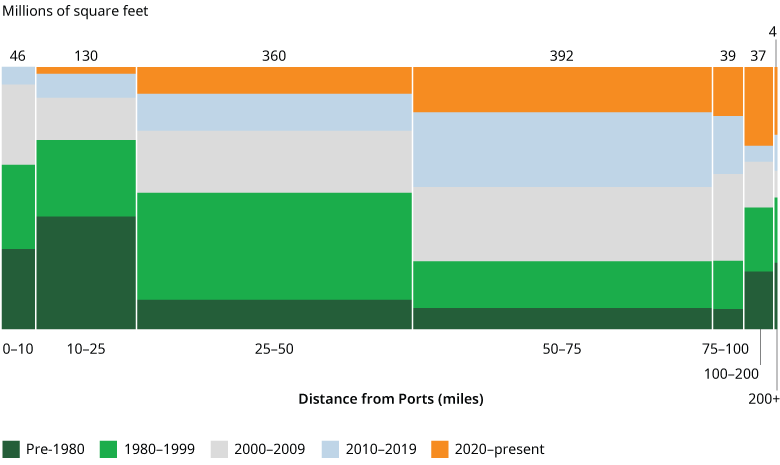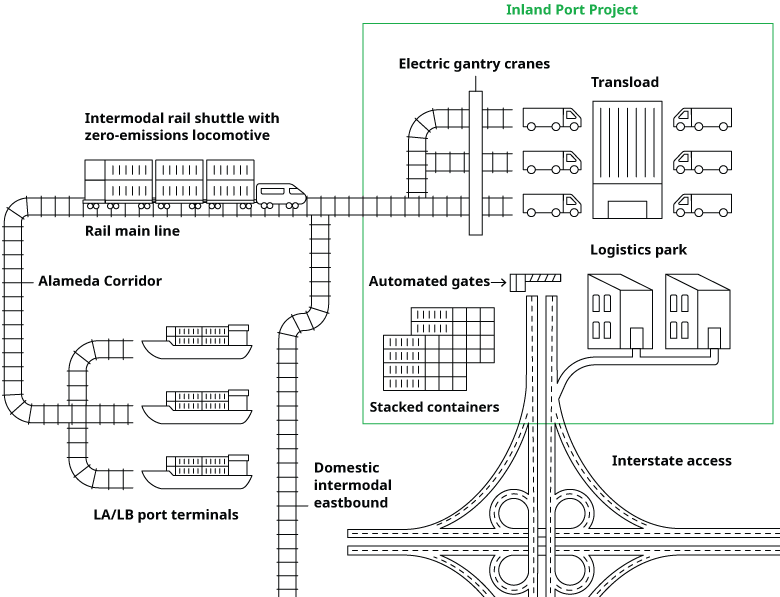The Ports of Los Angeles and Long Beach are the nation’s premier container ports, accounting for 30% of North American containerized imports and exports. They also play an important role in the Southern California economy. But the ports are facing a range of challenges in maintaining their current economic role, supporting plans for future growth, and ensuring they remain competitive. In addition, Southern California is an increasingly difficult market for shippers that need to truck import containers inland from the ports, due to rising costs, emissions requirements, road congestion, and increasing haulage distances, since there is limited land available nearby for industrial development.
Unlocking the potential of inland ports
One potential option that could reduce truck traffic in the region and lower shipping costs would be to employ short-haul rail intermodal to an inland port. Essentially, a rail shuttle, using the ports’ on-dock rail capacity, could move import containers to a truck/rail terminal further inland (an “inland port”). Some of the activities that traditionally occur at or near the ports, such as freight sorting, pickup, and transloading (from marine to domestic containers) would then be done at the inland port.
The concept could potentially support several key objectives for the Los Angeles and Long Beach ports, including increasing supply chain performance and capacity, and helping reduce road congestion and air pollution from heavy trucks in the Los Angeles Basin. Rail shuttle-inland port services are successfully being used at other North American container ports today, including Virginia, Savannah, Charleston, and Vancouver.

How an inland port could benefit Southern California
Oliver Wyman and Leachman and Associates were commissioned to assess at a high level the operational, service, and economic feasibility of the rail shuttle-inland port concept for Southern California. Key findings include an addressable market of 3.1 million to 4.6 million TEUs (twenty-foot equivalent units), due to the presence of many large retailers and original equipment manufacturers in the area with substantial transloading needs. At full capacity, this could eliminate some 5,100 short-haul truck moves (drayage) every weekday. Additionally, a rail shuttle-inland port service could be cost competitive on a per container basis for shippers compared to direct truck drayage — as long as the inland port is integrated with or located near freight logistics and warehousing facilities.
Inland ports could be built under different models: a small standalone terminal with two or three shuttle trains a day could shift up to 15% of Inland Empire port drayage. A large inland port with five to 10 shuttle trains per day and a large integrated logistics park could shift a quarter to nearly half of Inland Empire port drayage at full capacity.
By moving certain operations inland, the Los Angeles and Long Beach ports would be able to grow volumes without expanding their physical footprint — and without adding yet more trucks to local highways (like the I-710) that are unlikely to be further expanded. Central regions of California have significant undeveloped land and communities looking to expand their economies, and so could be willing to support the development of logistics facilities and warehousing.

There are of course challenges in implementing the rail shuttle-inland port concept, including ensuring sufficient mainline rail capacity, the potential need for a day-one zero-emissions operation, site selection/permitting, and securing government support. But the study illustrates that the concept could provide benefits to all major stakeholders in the Southern California intermodal inland transportation chain, including the ports, shippers, carriers, and state/local governments.
The “Feasibility and Benefits of Intermodal Service in Short-Haul Markets” report was commissioned by Pacific Harbor Line (PHL), as the neutral operator of the Los Angeles and Long Beach ports’ on-dock rail network, after several stakeholders proposed that PHL develop the study utilizing independent experts to help understand the potential for short-haul rail intermodal to inland terminals on a location-agnostic basis. PHL neither controls nor has rights to serve any short-haul routes or markets outside of the ports. This study does not presume what terms would be acceptable and ideally accretive to private sector stakeholders, nor does it presume any specific policy position by public sector stakeholders. The study is presented here with the permission of PHL.
Special thanks to Matthew Schabas who contributed to this report.
